Note: for the full suite of measurements from the SoundStage! Audio-Electronics Lab, click this link.
 It’s rare that I begin a review by confessing a personal bias, especially one directly relevant to the component I’m about to describe. Here goes.
It’s rare that I begin a review by confessing a personal bias, especially one directly relevant to the component I’m about to describe. Here goes.
I like big components—large, heavy ones, preferably in flashy cases with chunky faceplates and lots of heatsinks. And if the component bristles with tubes, odds are I’ll like it more. I guess part of my desire for big, ostentatious audio gear is the pleasure I take in building up a big, aesthetically pleasing system at the front of my listening room, right between my speakers. I’ve got a big, heavy audio rack, so I guess it’s reasonable for me to fill it with boxes to match. At least that’s what I tell myself.
And those capacious cases need all that room inside for lots of circuitry, tons of power-supply capacitors, big transformers, gauges and dials, and, well, stuff. Right?
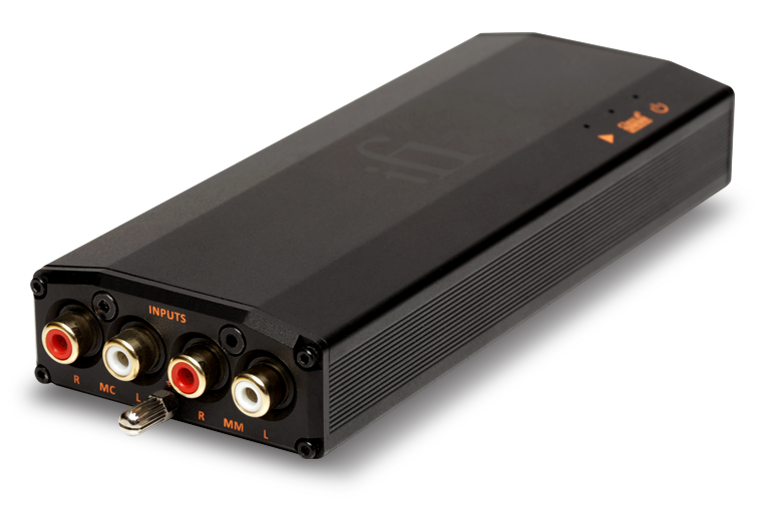
Maybe not so much. This month I review the smallest active component ever to visit my system: the iPhono3 Black Label phono stage ($999, all prices USD) from iFi Audio, which has made its name with small components.
In short: One of my audio biases has been smashed wide open.
Shrink down
I’ve been vaguely aware of iFi Audio’s extremely cool, jewel-like components, which for the most part are related to headphones, so I’d assumed that iFi’s bread and butter are DACs and headphone amps. They have a number of models of each, in several lines, and their prices tend to be low.
Which means I hadn’t paid much attention to iFi’s phono stages, having made another assumption: that they were probably entry-level units, an attempt to cash in on the upsurge in vinyl’s popularity.
So when the iPhono3 Black Label came my way, I did some digging. Turns out the iPhono3 is directly descended from the PH-77, a cost-no-object phono stage ($11,995) made by iFi’s parent company, Abbingdon Music Research (AMR).
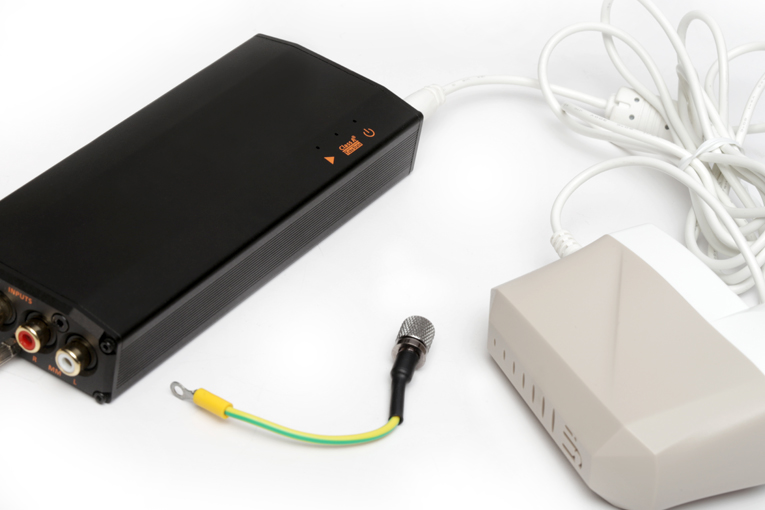
Inside the iPhono3 lurk some interesting technologies and features, and parts of extremely high quality. Right on the box, iFi states that the iPhono3 runs in a version of class-A they call Class A TubeState, which they describe thusly:
The Class A buffer minimises the loading of the amplifier circuit AND at the same time reliably biases the output stage of the integrated circuit amplifier into single-ended Class A (it normally operates in Class AB). . . .
Tube-state does not mean to add a lot of synthetic harmonics, but to emulate core features of tube circuits in solid-state. The result is a sound that combines the best features of the tube sound (lack of grain, edginess and naturalness of sound) with the best of modern solid state (low distortion, low noise).
For the iPhono3 Black Label there is a third-generation upgraded circuit that has at the heart top-notch op-amps & hand-matched PNP bipolar transistor Class A Tube-state Buffer.
I mentioned high parts quality. This is where iFi has so befuddled me. Into this tiny package they’ve stuffed hand-matched Burr-Brown J-FETs, Panasonic PCPU film capacitors, Nichicon and TKD capacitors, computer-matched bipolar input transistors, and Vishay resistors. That much heavy artillery is usually found only in big, heavy chassis that take up a lot of shelf space.
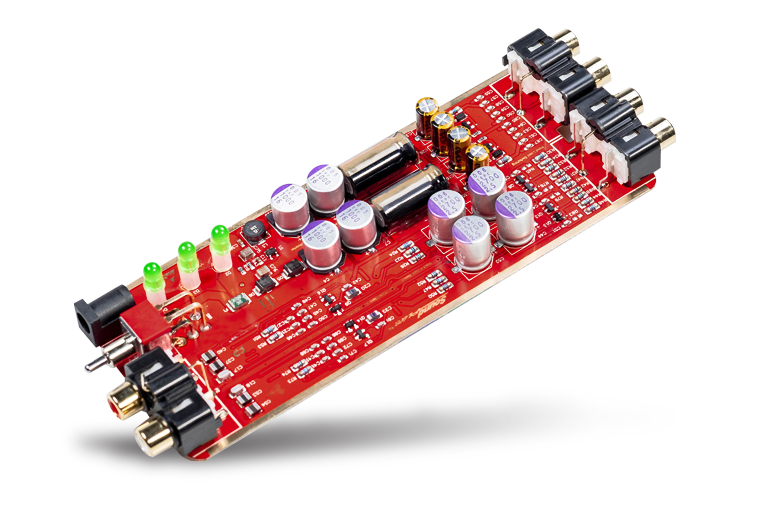
As a result of their careful parts selection and surface-mount construction, iFi has achieved in the iPhono3 a dynamic range of 107dB. Don’t kick me in the balls here—I know there’s not an LP made that comes even close to that kind of range. What’s important is that, to achieve so wide a dynamic range, iFi must keep the noise to vanishingly low levels, and when you’re dealing with 72dB of gain, a low noise floor is something you’ll definitely notice.
Let’s look at adjustability. The iPhono3 is designed to accommodate pretty much any cartridge out there. Flip this little guy on its back to find 24 DIP switches in three columns, for setting gain, loading capacitance for moving-magnet (MM) cartridges, loading resistance for moving-coil (MC) cartridges, and the RIAA equalization curve. Each set of eight DIPs is set up as dual mono: four each for the left and right channels, in mirror-imaged number sequence. For MM cartridges, there are five capacitive loading options from 100 to 500pF. For MC cartridges, there are seven resistive loading options from 22 ohms to 1k ohms, and 47k ohms for high-output MCs. I settled in nicely with 100 ohms for my EAT Jo N°8 cartridge.
The gain options are 36, 48, 60, and 72dB, the highest number being likely to satisfy all but the most waif-like of cartridges.

In terms of EQ, iFi has taken a step far beyond what many consider mandatory. In addition to the standard RIAA curve, the iPhono3 includes eRIAA, Columbia, Decca, IEC, and eRIAA+IEC. I’d need far more pixels than are available to me to detail the implications of the varying EQ curves accommodated by the iPhono3. Suffice it to say that pretty much every modern LP is encoded with the RIAA curve. If you want to get the most out of older LPs made with one of those other curves, it’s worth exploring those other settings—but if your collection is anything like mine, if you set the iPhono3 to RIAA and leave it there, you’ll be fine for 99% of your listening.
I first tried to set the iPhono3’s DIP switches by myself, but after three tries it still didn’t sound right. I consulted iFi’s website and discovered their iPhono Calculator. Select your model of iPhono, then plug in your cartridge’s type (MM, MC, or high-output MC), load in ohms, and the EQ curve you want to use—it spits out easy-to-read charts of settings for the three banks of DIPs. Using the supplied plastic switching tool, it was easy to set the DIPs to match my needs.
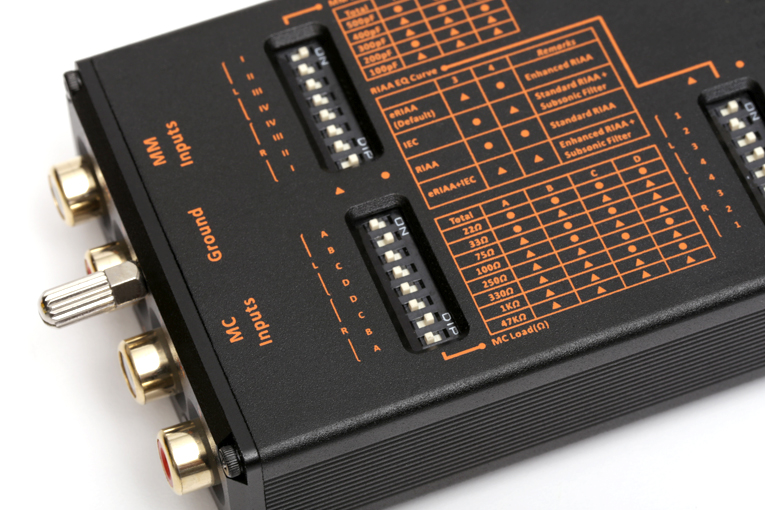
The iPhono3 also includes a ground extension that came in handy, given how little real estate its tiny endpanel has for connections. Speaking of those panels, on one end of the iPhono3 are pairs of RCA input jacks (MM and MC), and between them the ground post. On the other end are the output jacks (RCA), and a jack for the iPower X power supply.
The iPower X is a wall wart on steroids—there’s a lot to it. It uses iFi’s Active Noise Cancellation II circuit, which cancels incoming EMI and RFI noise. iFi has spent some money on parts selection here too, using larger solid organic capacitors, which they claim reduce capacitance leakage and high-frequency noise.
The iPower X supply comes in a separate box but is included in the iPhono3’s price. A smaller wall-wart supply is included in the iPhono3’s box, but iFi strongly recommends using the iPower X.
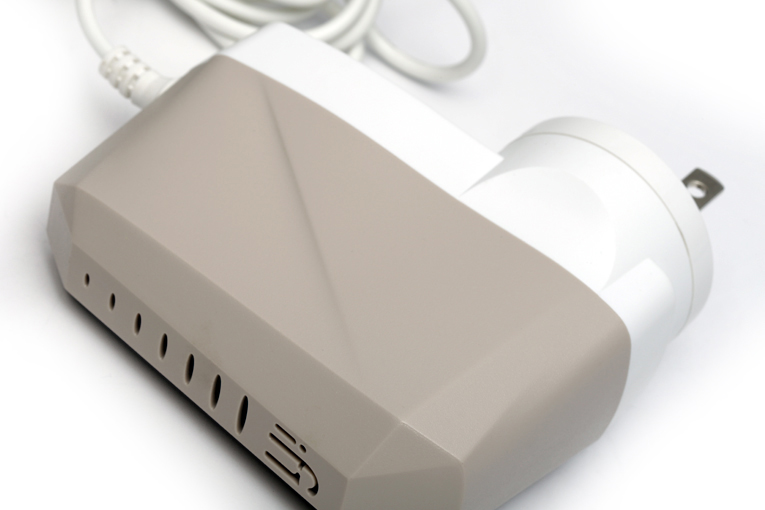
Also included are a pair of decent phono cables, and a grounding adapter that you can plug into an IEC socket at the end of a power cord. In this female IEC socket, only the ground is connected—you could plug a power cord into your power bar, and its IEC end into this adapter. At the other end of the adapter is a small spade connector, to be connected to the iPhono3. My system has no ground problems, but it’s thoughtful of iFi to include this sanitary, alternate way to ground the iPhono3.
So small . . .
Here’s the clash of assumptions that smashed my bias wide open.
In its white cardboard box, which is well finished and nicely compartmented, the iFi Audio iPhono3 is about the size and shape of a packaged smartphone. Indeed, after unwrapping it, I found that my Samsung S10+ phone could completely cover it. That’s small—I’ve used bigger remote controls. At just 2.3ʺW x 1.1ʺH x 6.2ʺD and little more than half a pound, it easily fit under my VPI Prime Signature turntable with plenty of room to spare.
I placed the iPhono3 on my rack, between my Sonic Frontiers SFL-2 preamp and Aqvox Phono 2 Ci phono stage. It took up almost no space at all. However, it has connections on both ends, which calls for some creativity in dressing interconnects. It makes just as much sense to hide the iPhono3 behind another component—if it were to take up permanent residence in my system, that’s what I’d do.
. . . but packs a punch
As I mentioned, it took me three tries and a trip to the iPhono Calculator to get the iPhono3 Black Label set up correctly. The first two listens were most unsatisfactory. I was well aware that the iPhono3 is built around some serious tech chops, so I knew the problem was on my end. It was immediately obvious when I got the settings right. Once I’d set the phono curve to RIAA and the impedance to 100 ohms, the sound opened right up.
That done, my first impression was that the iPhono3 was unbelievably silent. Though my Aqvox phono stage is fairly quiet, there’s a bit of hum when I turn the volume up. But with the iPhono3? Nothing. With it set to 60dB of gain, the noise floor was below that of my tubed preamp. This is important: The tiny iPhono3 and its iPower X wall wart were not only as quiet as my Aqvox, they were on a par with the Constellation Andromeda phono stage I reviewed last year. The Constellation retails for $19,900, or precisely 19.919919 times more than the iPhono3.
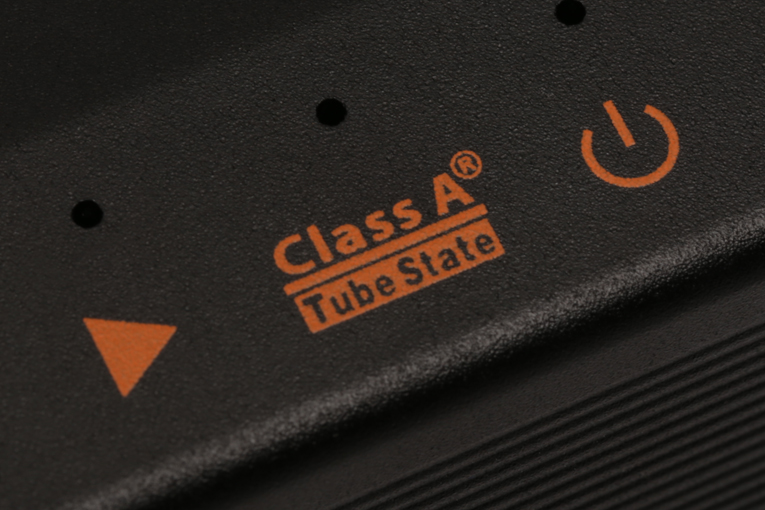
When I began listening to the iPhono3, I planned to review it in isolation—a component must be able to stand on its own merit. But the more I listened, the more I found myself reflecting on my time with the big, ostentatious Constellation Andromeda. These two phono stages couldn’t be more different—massive, heavy, expensive vs. tiny, light, affordable. But in terms of sound, they were more alike than different. Color me surprised.
I’m not a huge Jack White fan, but in the past couple years I’ve been swamped with records by White and by his bands, the Raconteurs and the White Stripes, thanks to my subscription to the Vault service of the label White owns, Third Man Records. Each quarter I receive an album on vinyl that, more often than not, is some kind of Jack White music, and it’s generally fun stuff. Right now I’m listening to XX (LP, Third Man TMR-649), a compilation of White Stripes outtakes. It’s better than you might think. Side 3 is a live performance of some sort, and while Meg White can’t drum her way out of a wet paper bag, it’s entertaining. Listening to Jack White’s crisp, crackling guitar through the iPhono3, I found myself focusing on how it handled aggressively played harmonics—leading edges had that sharp attack that you associate with live rock music, an instant-on acceleration that not all phono stages can reproduce. I generally associate wide dynamic swings such as this with a huge power supply—lots of caps, a big transformer. The iPhono3 has neither, yet delivered transients with satisfying bite.
More than satisfying. Listening to the half-speed-mastered version of the Tragically Hip’s Day for Night (LP, Universal 7747461) gave me a whole article’s worth of material. Crunching guitar once again, as “Grace, Too” filled my room with flying glass. iFi’s ad copy makes much mention of wide dynamic range and high signal/noise ratio, and heck, maybe that’s how the iPhono3 managed to slam out transients so impressively. We’ll be measuring it, so maybe we’ll find out.
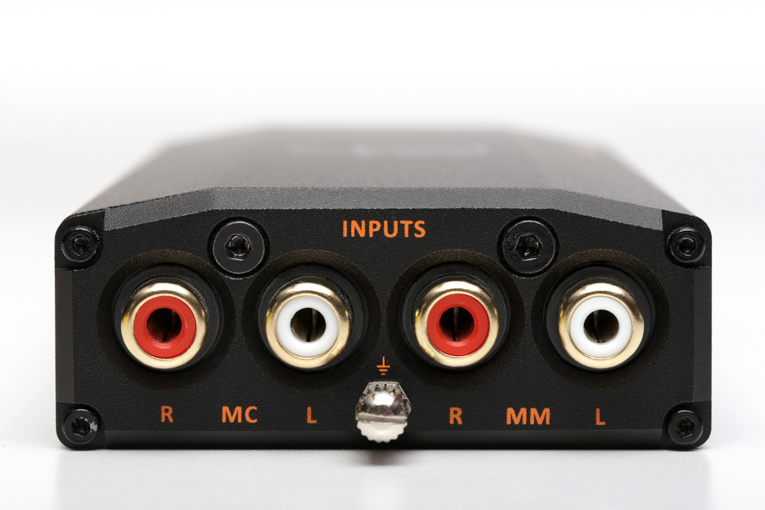
I was swapping out my EAT Jo N°8 cartridge for my Roksan Shiraz. One—little—slip of the needle-nose pliers and I ripped a flying lead right off the Shiraz’s body. The horror! The cartridge itself is fine, but it’s dead to me until I can get that lead soldered back on, and that sort of microsurgery is beyond me. Maybe if I were Bones McCoy in “Spock’s Brain” (Star Trek, Season 3, Episode 1, 1968), I’d growl, “It’s so easy, a child could do it.” Ain’t gonna happen. So back to the Jo N°8 and the Hip’s “Greasy Jungle.”
iFi makes a big deal of the iPhono3’s Class A TubeState circuit. But did it sound tube-like? Well, not in the usual sense of the term. Its sound wasn’t as rich and fruity as that of my Sonic Frontiers SFL-2 tubed preamp, but I could hear where iFi is going with this concept. There was definitely a heft, a feeling of body and texture in the iPhono3’s reproduction of aural images.
Every once in a while, I need to be challenged by music. “Have you heard the latest Diana Krall album?” an acquaintance might ask. I’ll get all up in his face: “No! I’m too busy listening to Mike fucking Patton!” Case in point: the physical assault of John Zorn’s The Last Judgment (LP, Tzadik TZ 6009). With his rich tenor voice, Patton can soothe you, shriek like a Japanese schoolgirl, or howl like he’s got rabies. In “Tria Prima” he does all three, as he launches into a jabbering diatribe. This is super-heavy metal with bass, drums, and organ.
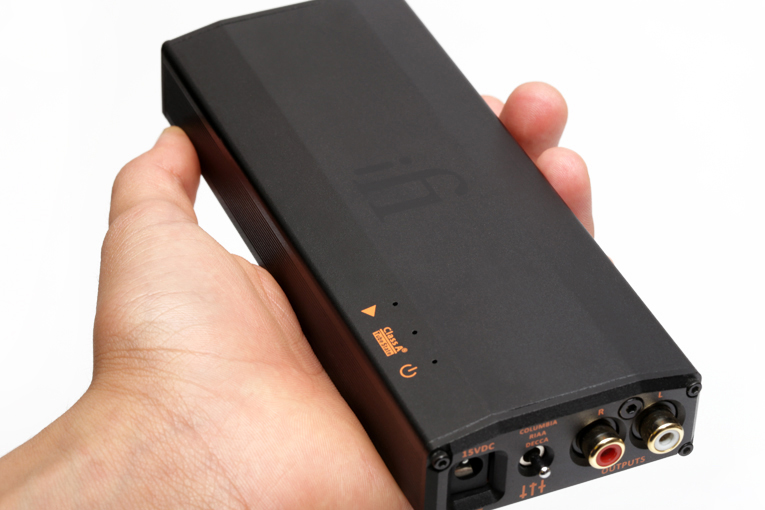
Played through a good system, “Tria Prima” should make you sweat, and via the iPhono3 it was appropriately terrifying. But here’s the cool part: abrasive as this track is, I could listen to it loud, and the louder I turned it up, the richer the images became. It was all there—deep bass, crisp highs, and solid, fleshed-out aural images. The iPhono3’s tininess utterly belied the huge sound it reproduced from this challenging recording.
Up punch
I ran some comparisons of the iFi iPhono3 with my Aqvox Phono 2 Ci (€1990). The two preamps were cut from the same tonal cloth, with some differences. The iPhono3 was quieter, in terms not only of hum but of presenting the music against “blacker” backgrounds. Further differentiating the two was the iFi’s way with transients—quicker and more dynamic, the iFi topped the Aqvox with snappy, aggressive music, managing a fine balancing act of belting out the leading edges of notes while adding no grit or distortion.
In terms of soundstage depth and precision of imaging the battle was more of a draw, and in some ways tilted in the Aqvox’s favor. The iFi sure did present a rich, detailed soundstage—but so does the Aqvox. There was a touch more depth to images as presented by the Aqvox, a little more sense of the absolute recording space. The iPhono3 countered with images that were more solidly constructed. My taste leans more toward the Aqvox’s more diffuse, slightly bigger images, but I reckon there’s a fair number of folks who’d be happier with the iPhono3’s precision.
Conclusion
Based on all I’ve said about iFi Audio’s iPhono3, you’ve probably already got your credit card out and are ready to punch in your CVV. I won’t try to dissuade you. If you’re looking for a small, reasonably priced phono stage that sounds really, really good and is flexible enough to grow with your system, well, this is your baby. While it’s not the type of component that you can proudly show off and thus elevate your social standing among image-conscious audiophiles, it sure sounds swell, and it’s a devastating bargain. Unconditionally recommended.
. . . Jason Thorpe
jasont@soundstagenetwork.com
Note: for the full suite of measurements from the SoundStage! Audio-Electronics Lab, click this link.
Associated Equipment
- Analog sources: VPI Prime Signature turntable; EAT Jo N°8, Mobile Fidelity Master Tracker, Roksan Shiraz cartridges
- Digital source: Logitech Squeezebox Touch
- Phono stage: Aqvox Phono 2 Ci
- Preamplifier: Sonic Frontiers SFL-2
- Power amplifiers: Bryston 4B3, Simaudio Moon 860A v2
- Integrated amplifier-DAC: Hegel Music Systems H90
- Speakers: Aurelia Cerica XL, Estelon YB, Focus Audio FP60 BE
- Speaker cables: Audience Au24 SX, Nordost Tyr 2
- Interconnects: Audience Au24 SX, Furutech Ag-16, Nordost Tyr 2
- Power cords: Audience FrontRow, Nordost Vishnu
- Power conditioner: Quantum QBase QB8 Mk.II
- Accessories: Little Fwend tonearm lift, VPI Cyclone record-cleaning machine, Furutech Destat III
iFi Audio iPhono3 Black Label Phono Stage
Price: $999 USD.
Warranty: One year parts and labor.
iFi Audio
Guildford
79 Scarisbrick New Road
Southport, Merseyside PR8 6LJ
England, UK
Phone: +44 (0)1704-543-858
Abbingdon N.A./iFi audio USA
105 Professional Parkway, Suite 1506
Yorktown, VA 23693
1085 Blair Avenue
Sunnyvale, CA 94087
Phone: (800) 799-4342
Website: www.ifi-audio.com






















